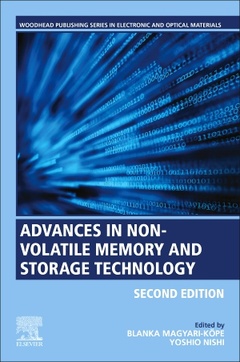Description
Advances in Non-volatile Memory and Storage Technology (2nd Ed.)
Woodhead Publishing Series in Electronic and Optical Materials Series
Coordinators: Nishi Yoshio, Magyari-Kope Blanka
Language: English
Subjects for Advances in Non-volatile Memory and Storage Technology:
662 p. · 15x22.8 cm · Paperback
Description
/li>Contents
/li>Readership
/li>Biography
/li>Comment
/li>
Advances in Nonvolatile Memory and Storage Technology, Second Edition, addresses recent developments in the non-volatile memory spectrum, from fundamental understanding, to technological aspects. The book provides up-to-date information on the current memory technologies as related by leading experts in both academia and industry. To reflect the rapidly changing field, many new chapters have been included to feature the latest in RRAM technology, STT-RAM, memristors and more. The new edition describes the emerging technologies including oxide-based ferroelectric memories, MRAM technologies, and 3D memory. Finally, to further widen the discussion on the applications space, neuromorphic computing aspects have been included.
This book is a key resource for postgraduate students and academic researchers in physics, materials science and electrical engineering. In addition, it will be a valuable tool for research and development managers concerned with electronics, semiconductors, nanotechnology, solid-state memories, magnetic materials, organic materials and portable electronic devices.
Part 1: Progress in nonvolatile memory research and application 1. OxRAM technology development and performances 2. Metal-oxide resistive random access memory (RRAM) technology: Material and operation details and ramifications 3. Advanced modeling and characterization techniques for innovative memory devices: The RRAM case 4. Mechanism of memristive switching in OxRAM 5. Interface effects on memristive devices 6. Spin-orbit torque magnetoresistive random-access memory (SOT-MRAM) 7. Spin-transfer-torque magnetoresistive random-access memory (STT-MRAM) technology 8. 3D-NAND Flash memory and technology 9. Advances in oxide-based conductive bridge memory (CBRAM) technology for computing systems 10. Selector devices for x-point memory
Part 2: Emerging opportunities 11. Ferroelectric memories 12. Advances in nanowire PCM13. Flexible and transparent ReRAM devices for system on panel (SOP) application 14. RRAM/memristor for computing 15. Emerging memory technologies for neuromorphic hardware 16. Neuromorphic computing with resistive switching memory devices
academic researchers and R&D professionals in materials science, physics, and engineering
Blanka Magyari-Köpe received her Ph.D. degree in physics from the Royal Institute of Technology, Stockholm, Sweden, in 2003. Since 2006, she has been an engineering Research Associate and from 2011 a Senior Research Engineer in the Department of Electrical Engineering at Stanford University. Prior to this position she was a postdoctoral researcher in the Department of Materials Science and Engineering, University of California, Los Angeles
- Discusses emerging devices and research trends, such as neuromorphic computing and oxide-based ferroelectric memories
- Provides an overview on developing nonvolatile memory and storage technologies and explores their strengths and weaknesses
- Examines improvements to flash technology, charge trapping and resistive random access memory




